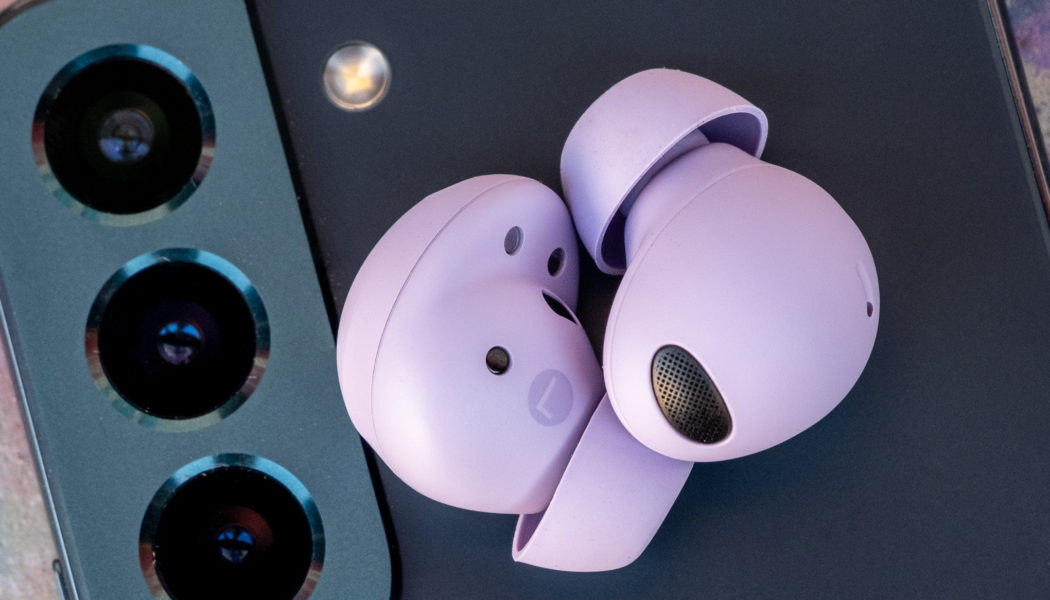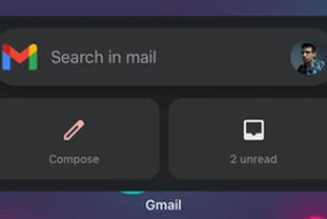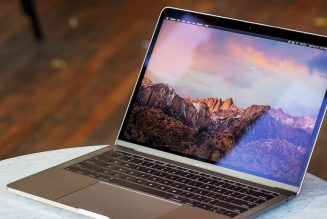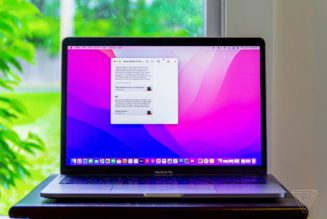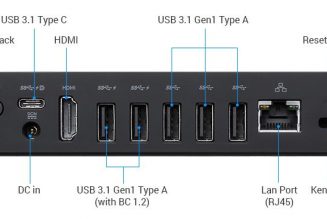We’re entering new territory in the walled garden earbud wars: to get the very best audio quality from Samsung’s Galaxy Buds 2 Pro, you need to use them with a Samsung phone. It was always going to come to this. Between Apple’s AirPods, Samsung’s Galaxy Buds, Google’s Pixel Buds, and other earbuds developed by companies with a deep-rooted interest in the smartphone world, we’ve already seen many convenience-minded features — one-touch setup, automatic device switching, head-tracking spatial audio, and others — that incentivize consumers to match their brand of buds with the phone in their pocket. The goal is to lock you into that ecosystem as you gradually upgrade one device and then the other in perpetuity.
But the $229 Buds 2 Pro are the first to play up superior sound quality as the big exclusive. Connect them to any recent Samsung phone, and you can wirelessly stream “24-bit hi-fi audio” from services like Apple Music, Amazon Music, Tidal, Qobuz, and others that offer lossless and high-resolution music catalogs. Samsung claims this results in substantially richer audio and a better listening experience from where things stood before.
I’ll dig into all of that more later, but the important takeaway is that the Galaxy Buds 2 Pro, thankfully, are terrific earbuds no matter what kind of phone you have. Over more than a week of testing, I’ve found them to be Samsung’s best-sounding, most comfortable buds yet.
How we rate and review devices
The Buds 2 Pro are 15 percent smaller than the original Galaxy Buds Pro, and both the earbuds and case now have a matte soft-touch coating. I prefer it over glossy plastic: the case stays smudge-free, and the buds are easier to grip with the coating. The new earbuds are lighter, too (now down to 5.5 grams per earbud), and have a larger vent on the exterior for improved airflow and to mitigate any unpleasant “plugged-up” feeling. They’ve proven nothing but comfortable in the days I’ve been using them so far and have reliably stayed in my ears. Battery life is completely unchanged from the prior model, promising five hours of listening time with ANC enabled and eight with it off — plus another 18 / 28 via the charging case. That’s adequate stamina for most situations but nothing special in 2022. The Buds 2 Pro maintain the same IPX7 water resistance rating as their predecessors.
It doesn’t take long to conclude that these earbuds have fantastic sound. With a dual-driver design and tuning by AKG, they eclipse the AirPods Pro by a country mile — not a surprise given that Apple’s buds are approaching three years old. But they also surpass the excellent Pixel Buds Pro in this department and are closer in line with my favorite earbuds like Sennheiser’s Momentum True Wireless 3 and Sony’s WF-1000XM4. They’re supreme performers with a level of depth and detail that their big tech contemporaries can’t quite match.
The Hold Steady’s “Heavy Covenant” demonstrates their separation and clarity, giving the guitars, horns, and Craig Finn’s recognizable vocals ample room to breathe. As a devout ’90s music fan, I hopped back to “Omaha” by Counting Crows, and the Buds 2 Pro brought out the warmth of the accordion and mandolin while giving the drums a natural kick. Returning to modern life with Orville Peck’s “The Curse of the Blackened Eye,” I was impressed by the wide soundstage Samsung has given these buds.
:no_upscale()/cdn.vox-cdn.com/uploads/chorus_asset/file/23956548/DSCF8758.jpg)
But is it genuine “hi-fi” sound? After more than a week, I’m still trying to suss that out. Samsung says its new Seamless codec lets the Buds 2 Pro wirelessly stream 24-bit, 48kHz audio over Bluetooth. But the company has been less transparent about the bitrate of that audio. For reference, Sony’s LDAC codec tops out around 990kbps, which still falls short of lossless CD quality. Samsung spokesperson Jordan Guthmann told The Verge by email that Samsung Seamless Codec can reach a bitrate of up to 2304kbps, which would indeed work out to lossless, hi-resolution sound.
That number has me skeptical. It would be a monumental leap over existing earbuds, and there’s nothing in the Android developer settings menu that confirms bitrate details — only the 24-bit / 48kHz part. The higher-quality streaming works with any Galaxy smartphone running Android 8.0 and One UI 4.0 or later (with 1.5GB RAM or above). That’s a lot of phones, which adds to my confusion about the bitrate and how Samsung could possibly be hitting 2304kbps. More to follow, hopefully, but don’t get lost in the numbers: these earbuds really do sound great as long as you’ve got a good seal and twist them snugly. They’ll also support Bluetooth LE Audio down the line, though Samsung hasn’t specified what benefits that will bring.
The active noise cancellation is satisfactory. When you’re not playing any music, you’ll hear what’s happening in a coffee shop; this is the tradeoff for those bigger air vents and extended comfort. But once any audio is playing, the background fades away convincingly, and you’re unlikely to notice any distractions — even with the volume around 30 percent. The transparency mode works well but still not quite as natural-sounding as on the AirPods Pro. I don’t know why it’s so hard for companies other than Apple to get that right even now.
Samsung’s head-tracking spatial audio does what you’d expect, shifting the soundscape as you turn from side to side. I’m finding more and more that this is a love-it-or-hate-it type feature for people. Personally, I still like taking advantage of 360 audio when watching video content, but I remain unconvinced it’s any kind of game-changer for music. Samsung’s Galaxy Wearable app (only available for Android) lets you customize sound EQ, but noise cancellation is either on or off with no manual adjustments permitted.
Samsung is still lagging behind in some categories. Google included multipoint Bluetooth connectivity on the Pixel Buds Pro, and the ability to pair with two devices simultaneously is a huge perk. The best Samsung can do is automatically switch between Samsung-branded products, whether those are laptops, phones, tablets, smartwatches, or even TVs. Maybe that’s convenient if you live neck-deep in the Samsung world, but I don’t know anyone who does, and it fails to provide the same multitasking convenience as proper multipoint.
:no_upscale()/cdn.vox-cdn.com/uploads/chorus_asset/file/23956546/DSCF8720.jpg)
Other ideas are blatantly copied. Samsung’s Voice Detect feature works much the same as on Sony headphones: when the earbuds detect that you’re speaking, they’ll automatically enter transparency mode and drop the volume for a configurable amount of time, between five and 15 seconds. Self-mumblers will want to avoid this one. And then there are the strange features, like the off-by-default “neck stretch reminders” that use the earbuds to detect if you’ve been hunched over with poor posture for 10 minutes. When that happens, a voice chimes in with a “time to stretch your neck” audio alert. I ended up leaving this turned on, as I’m about to be 38 — no more slouching.
Samsung’s tap controls can be a hair over-sensitive at times, so you might pause a track when adjusting an earbud. Surprisingly, there’s no auto-pause here, meaning tunes or podcasts will keep playing if you remove one of the Buds 2 Pro from your ears. That’s a strange omission for $230 earbuds, but not one I’ve been too frustrated with in practice.
As you can hear in our latest Vergecast microphone test, the Buds 2 Pro wouldn’t be my top pick for voice calls aboard a loud ferry boat. But in more traditional, everyday use cases, they get the job done. Sony’s LinkBuds and Google’s Pixel Buds Pro both edge out Samsung’s latest flagship earbuds at overall mic quality, however.
The Galaxy Buds 2 Pro are Samsung’s best wireless earbuds yet: the company has struck a winning formula of sound quality, noise cancellation, and comfort. They’re at their best when operating in Samsung’s ecosystem but still plenty good with other Android devices. Some will find it frustrating that hi-fi audio is limited to Samsung’s own phones. But this is a preview of where the tech industry is likely headed: Apple’s next AirPods Pro are rumored to support wireless Apple Lossless playback on iPhones. The walls are climbing higher and higher between tech’s biggest players, even if there are still terrific, platform-agnostic earbuds available from Sony, Sennheiser, Jabra, and others. Google’s Pixel Buds Pro are worth a close look if you’re a big proponent of multipoint, but the Buds 2 Pro represent Samsung in top form.
Photography by Chris Welch / The Verge
